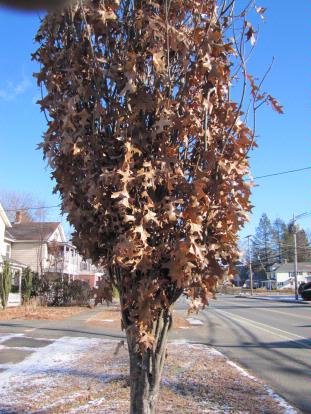Fire up your favorite internet search “engine” and poke in the word “oak.” Try the same thing with “oak tree.” This morning I did this exercise and was surprised at the difference.
In Google, “Oak tree” yields information about Quercus species and the various sections within the genus. Mr./Mrs. Google also finds information on country clubs, restaurants and various businesses with Oaktree in their names. Some specialize in “high-yield distressed debt.” Do they rescue clients by offering desperately needed bailouts, or do they take advantage of companies and countries that are on their knees to extract every last dime before selling the detritus to the highest bidder? If the latter, why would they name themselves after something so lovely as an oak? They should name themselves after a plant like a cancer root (Conopholis Americana), a parasitic plant of oak forests.
Searching for just “oak” returns Oak NYC a “cutting edge retailer offering…” all black clothing for people with more money than wits. If you find yourself in that category, they will be glad to sell you a $90.00 all-cotton T-shirt made by slave labor that says “in hale” and features the Van Halen logo made to read WTF. If you don’t know what the Van Halen logo looks like, you probably spent the 80’s doing something more sensible than I did.
Mr/Ms. Google seems to think that when I type “oak” into their search engine I’m wondering about over-priced black clothing. Have I been sleep shopping for my hipster alter-ego? I’m sure my sisters would argue that I really am just an under-capitalized hipster.
I was looking up oak because I was interested in marcescence, the trait of holding dead leaves through the winter. There are some traits that have an obvious selective advantage: porcupine quills, skunk anal glands and sharp teeth in carnivores. Marcescence is not such a trait. While it is true that evergreen trees retain their leaves, most evergreens in snow/ice country have very small leaves and are shaped in such a way that they are less susceptible to damage from ice storms. Oak leaves are relatively big (compared to say pine) and the trees have big snow accumulating branches.

I’ve read a few theories, most scan as “hand-waving.” That is they sound OK if you’re not paying close attention. The most common is that oaks evolved in a southern climate and only started moving north after the ice age and didn’t need to drop leaves around the frost. This argument essentially suggests that the trait is not-adaptive and if it poses a problem will eventually disappear. I don’t buy it because oaks of the Mediterranean are also marcescent (Sanchez de Dios et al Plant Ecology 2009).
Another theory has to do with nutrient recycling. It argues that the leaves are dropped around the tree base in the spring when nutrients are needed for growth. This seems even less likely because the important nutrients (nitrogen, phosphate, potassium, calcium etc.) are sucked back into the tree before the leaf dies. Most of what’s left is carbon and plants easily get carbon from the air.
The most convincing theory, at least to me, argues that leaf abscission happens due to water stress at the junction between leaf and branch. Trees that are adapted to low water conditions don’t suffer from water stress as easily, so the leaves stay on (Escuderoand Arco Oikos 1987). Couple this with the idea mentioned above that the oaks are newish immigrants to snow country, and you’ve got a theory that makes a bit of sense. Now back to shopping for black clothing.


